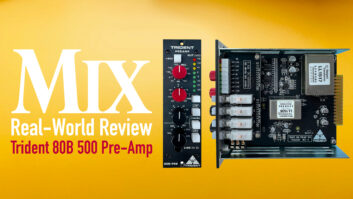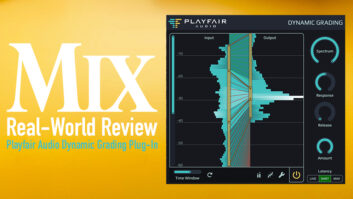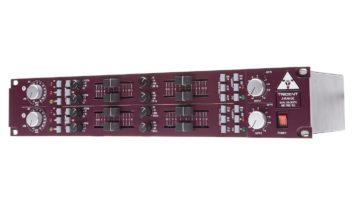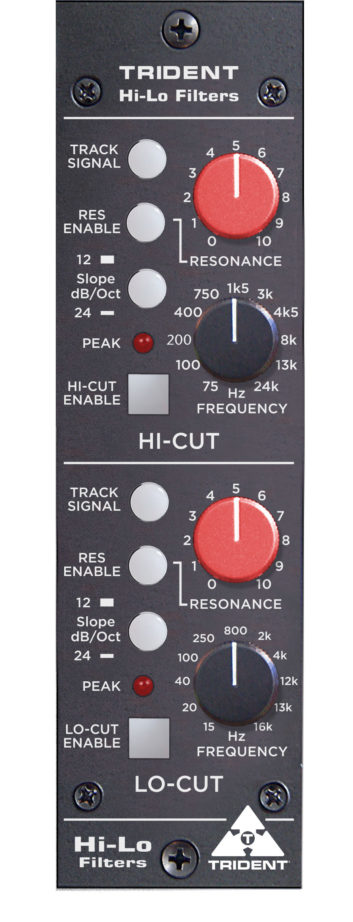 PMI Audio‘s Trident Audio Developments Hi-Lo Dynamic Filters is a single-channel 500 Series module that has two separate shelving filter sections: a Hi-Cut (lowpass) and Lo-Cut (highpass). Both filters are based on the dynamic tracking filters in the CLM Dynamics DB500 Expounder—a stereo four-band parametric equalizer that came out in the late 1990s. When I reviewed the DB500 in Mix in 1999, I thought the built-in tracking shelving filters were intriguing and had tremendous potential. However, the DB500 itself never really caught on with audio professionals and soon went out of production.
PMI Audio‘s Trident Audio Developments Hi-Lo Dynamic Filters is a single-channel 500 Series module that has two separate shelving filter sections: a Hi-Cut (lowpass) and Lo-Cut (highpass). Both filters are based on the dynamic tracking filters in the CLM Dynamics DB500 Expounder—a stereo four-band parametric equalizer that came out in the late 1990s. When I reviewed the DB500 in Mix in 1999, I thought the built-in tracking shelving filters were intriguing and had tremendous potential. However, the DB500 itself never really caught on with audio professionals and soon went out of production.
In 2005 Allan Bradford, the designer of the DB500 Expounder for CLM Dynamics, came to work for PMI Audio and soon afterwards CLM came up for sale. PMI’s Alan Hyatt bought the company in 2008 and has said: “I was thinking about those tracking filters in the DB500, and decided to resurrect and package them in a modern 500 rack module under the Trident brand.”
A Tracking Filter? Why Use One?
At a selected frequency, a tracking filter develops a control signal for a voltage-controlled amplifier to control the output level of audio passing through the filter. The speed and accuracy at which the filter can follow and trace the audio envelope is key to a good design because it makes the filter’s overall action transparent and effective—except when purposely set for a special effect.
Because it is an adaptive process, you are able to set a tracking filter much more aggressively compared to a conventional filter with fixed parameters. I have found better sonic results with less deteriorating side effects using the Trident Hi-Lo Dynamic Filters.
A hi-cut tracking filter is used for noise reduction by tracing the audio signal and “closing down” the high frequencies when there are fewer, or none at all, present.
Unlike noise gates that work on a fixed threshold level setting, a tracking filter is frequency-dependent. But just like with an opened noise gate, whatever noise floor (hiss, room noise, etc.) is still present is covered by the much louder audio.
Both noise gates and tracking filters rely on a psychoacoustic effect where the louder (wanted) audio signal “masks” much quieter signals (noise), even when occurring at the same frequencies.
A lo-cut tracking filter is useful for subsonic rumble, AC line hum removal or unwanted low frequency resonances. Removing AC hum (50 or 60 Hz) from a bass guitar will dynamically remove some of its low frequencies and requires a sonic compromise in extreme cases.
The addition of an adjustable Resonance control—short for Resonant Peak—on both the Hi-Cut and Lo-Cut sections in the Trident Hi-Lo Dynamic Filters is brilliant! Resonance is usually found on synthesizer filters, and here it is a proportional-Q peaking EQ circuit that is very useful when using a tracking filter.
Boosting with a resonant peak at the cutoff frequency will reduce the audible and apparent loss when rolling off the low frequencies in the Lo-Cut section. The amount of boost and Q varies depending on the selected cutoff frequency. At 16 kHz, the Q is 8, with a maximum boost of 15vdB. At 15Hz in the Lo-Cut section, the Q is 2, with up to 10 dB of boost possible.
Resonance boost variation increases linearly as frequency is increased in both the Lo-Cut and Hi-Cut sections for a stated specification of 12dB average. Using a resonant peak boost in the Hi-Cut section to compensate for high-frequency loss works, but, because the Q is higher, the added stridency may not be right for some sources.
Modernizing the Dynamic Filter
The original 3U DB500 Expounder used THAT Corp. VCA chips, and now some are obsolete. A major overhaul of the circuit was required for the newer THAT chips, improved up-to-date component quality, and getting it all to work within the power requirements and size of a 500 Series module.
Surface-mount technology is used throughout on a main board connected to the front panel sub-assembly board with a single ribbon cable. Also on the board are: THAT Corp 2162 (Dual Blackmer VCAs), a THAT 4305 RMS detector, and a THAT 1646 differential line driver output chip in a socket.
As the circuit is essentially the same as designer Allan Bradford’s DB500 design, like the original, I found the filters smooth, without ring, full-range and beautiful sounding. With regard to concerns about phase shift, Taz Bhogal, project design engineer for the PMI Audio Group, assures me that “with these types of filters the attenuation slopes and phase response curves are such that phase is linear and phase reversal occurs when attenuation is well below pass band.”
The Trident Hi-Lo Dynamic Filter has its two sections arranged so you can enable and adjust them separately. When both are engaged, they are connected in series. The front panel switch and control knob layout and operation copies the original DB500.
Starting at the bottom of the module is the sweepable Lo-Cut filter section with a frequency range of 15 Hz to 16 kHz. Above it is the Hi-Cut section with a sweepable range of 75 Hz to 24 kHz. Both of these sections are useable as conventional parametric shelving filters.
When in operation, a pair of Trident Hi-Lo Dynamic Filters is an impressive-looking light show of green, red, orange and blue! The lighted (when active) switch buttons and the four knob controls are in the same positions on both filter sections. I found no problems finding a control or switch instantly in my dimly lit studio.
There are separate blue-colored Enable (bypass) switches at the bottom of the Lo-Cut and Hi-Cut sections and a red Peak warning LED in each filter. The LEDs light up at +16 dBu or 12 dBU below clip at 27.5 dBU; it reads input peaks in bypass and then output when that section is enabled.
You have a choice of either a 12dB and 24dB per octave filter slope using the orange Slope button and red-lit Res Enable button switches the Resonance function in/out. At the top of each section is the green-lit Track Signal button to toggle tracking on/off.
There are just two control knobs on each section: the black Frequency sweep and the red (0-10) Resonance amount knob. I would like to get a set of metal Trident knobs (with set screws) instead of these plastic ones. It would make it easier to pull out the module from my 500 rack.
Stereo and Series Operation
The Hi-Lo Filters module comes with two internal switches that are switched off when shipped. There is a stereo link push button and a wire jumper to accommodate Radial Engineering’s Workhorse Power Racks. With this jumper in play, the module’s output is paralleled to pin 11 of the module’s edge connector for use in the mixer section of the Radial.
If your particular 500 Series rack supports stereo linkage between adjacent modules, then this switch inside must be pushed down to enable it. I feel like this switch should be on the front panel of the module as I have seen in other units. In stereo mode, the Tracking signal automatically follows the sum of the left and right modules, as it should.
For this review, I’m using a Trident Deca-Dent 10-space 500 Series rack, and it supports both stereo linking and series operation between adjacent modules. Both those features have toggle switches on the Deca-Dent’s back panel.
By connecting two Hi-Lo Filters in series, you’ll have a choice of 12, 24, 36 and 48dB/octave filter slopes in each filter. The Trident rack makes series operation easy, but it is the same as physically patching one module’s output to the other’s input.
When first getting to know Trident Hi-Lo Dynamic Filters, I tried one section at a time, without using Tracking. These are full-range, parametric filters, and depending on the positions of the frequency knobs, the modules may not pass audio at all! I used the filters on the hardware inserts in my Pro Tools HDX mixer.
Noise Reduction, Analog-Style
I received a song to mix that had a stereo sampled orchestral harp glissando recorded from an old Korg keyboard at very low and noisy level. It was a legacy, signature part, and there was no way to replace or play it again.
Besides electronic hiss, there was a low-frequency thump at about 200 Hz that actually lit up the peak LEDs on both sections of the Hi-Lo Filter. First, I used just the Lo-Cut filter set to 250 Hz and 24dB/octave. But as a conventional filter, the Lo-Cut section could not be set any higher than about 40 Hz without the sound thinning out.
Using the Tracking button, I was able to set the Lo-Cut frequency as high as 800 Hz, and the overall sound was nearly the same as in bypass, with very minimal loss of lows—amazing!
The Hi-Cut section worked well to control the amount of high-frequency noise; first, I set this roll-off at 4 kHz, and, of course, it dulled the sound. Switching in the Tracking function brought it all back to life. I could not hear any filter sweeping at all.
I developed an effect for a stereo synth bass track. Stereo? It was the original bass from the song’s demo, and in the chorus an interesting-sounding stereo pad mixed in with it on the same stereo track.
Originally recorded in Logic X, the track had very little stereophonic (non-correlated) information. In Pro Tools, I split-into-mono the stereo track and panned the two mono tracks mid-left and mid-right. On the left track, I put module 1’s Lo-Cut filter set at 100 Hz, 24dB slope, Resonance at 8 and Tracking on. On the right channel, I put module 2’s Hi-Cut filter set at 400 Hz, 12dB slope, Resonance at 10 and Tracking on.
Having radically different filter settings on channels panned mid-left and -right imparted an animated and wider tonality yet kept mono capability. I loved it, and so did the producer; it was subtle and different.
I had a percussive, muted picking guitar part that I ran through one Lo-Cut section only. I pushed all the buttons in—24dB slope, Resonance on, Tracking on and started with all the controls fully CW and got instant auto-wah! You may want to adjust the black Frequency knob for the amount of low frequencies. I got in the habit of putting a Trim plug-in ahead of the Trident module to act as a tracking sensitivity control especially good for this kind of effect.
Tonal Shaper
You have a powerful-sounding musical tone-shaping tool when patching two Trident Dynamic Hi-Lo modules in series. Seemingly wacky, extreme filter settings sounded good for guitars, synths and basses. Up to 48dB/octave is possible, and it is great to be able to have the ability to change between 12, 24, 36 or 48dB/octave by choosing different combinations of the 12/24dB octave switches on each module.
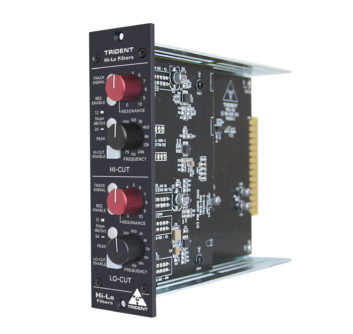 For a low and thick-sounding, drop-tuned guitar, I sent the guitar track out of Pro Tools to my first Hi-Lo module 1 and flipped the “1 into 2” switch on the back of the Deca-Dent rack and then returned module 2’s output back into the Pro Tools mixer.
For a low and thick-sounding, drop-tuned guitar, I sent the guitar track out of Pro Tools to my first Hi-Lo module 1 and flipped the “1 into 2” switch on the back of the Deca-Dent rack and then returned module 2’s output back into the Pro Tools mixer.
Wow! This is an awesome subtractive EQ guitar amp tone stack—it’s my new secret weapon! And since starting this review, I have wired a pair of Trident Hi-Lo Dynamic Filters in this configuration and leave them connected to the mic preamp output I use for electric guitars.
Using this method, you’ll find the first Hi-Lo in the chain does the majority of the subtractive EQ and the second Hi-Lo works well to fine-tune the effect. I found with low-frequency sound sculpting, the first Lo-Cut section in the chain would be 12dB/octave and without resonance. The second Lo-Cut section in series could be set at 12dB or 24dB but with Tracking enabled and some Resonance added. There is a lot of room for experimentation here, and there is no wrong or right way.
I found the Trident Hi-Lo Dynamic Filters very useful for fixing problems, creating interesting special effects, and accomplishing advanced tonal carving for unique and/or strange guitar tones. The list grows daily, and I usually find it connected in some capacity every day in my studio. This is one the most fun and simple-to-use new tools I’ve found lately. Highly recommended!
PRODUCT SUMMARY
Company: PMI Audio Group
Web: pmiaudio.com/store
Product: Trident Hi-Lo Dynamic Filter
Price: $499 MSRP
Pros: Great for audio noise repair, special effects, tone shaping.
Cons: Could use a front panel stereo link switch.
